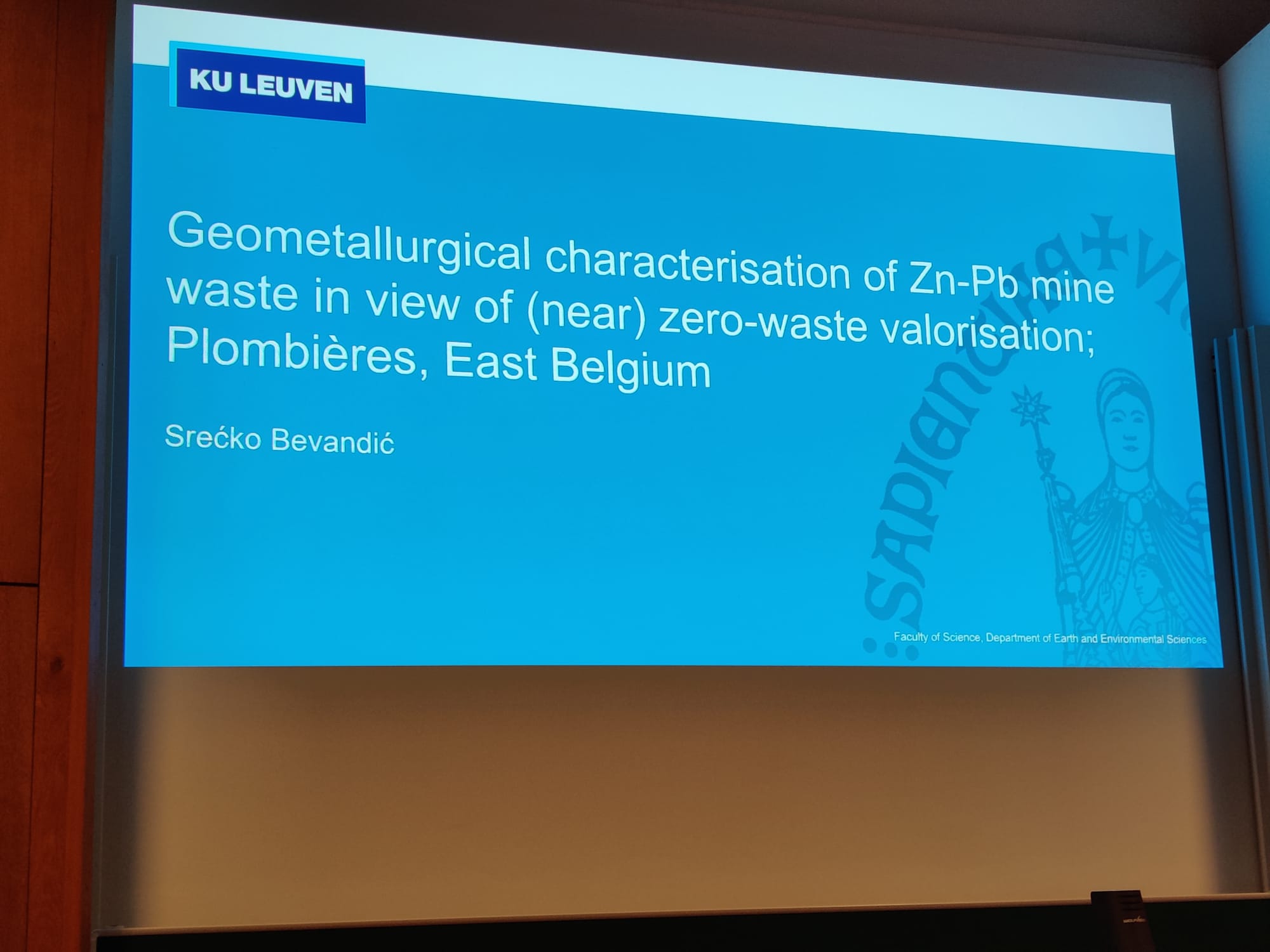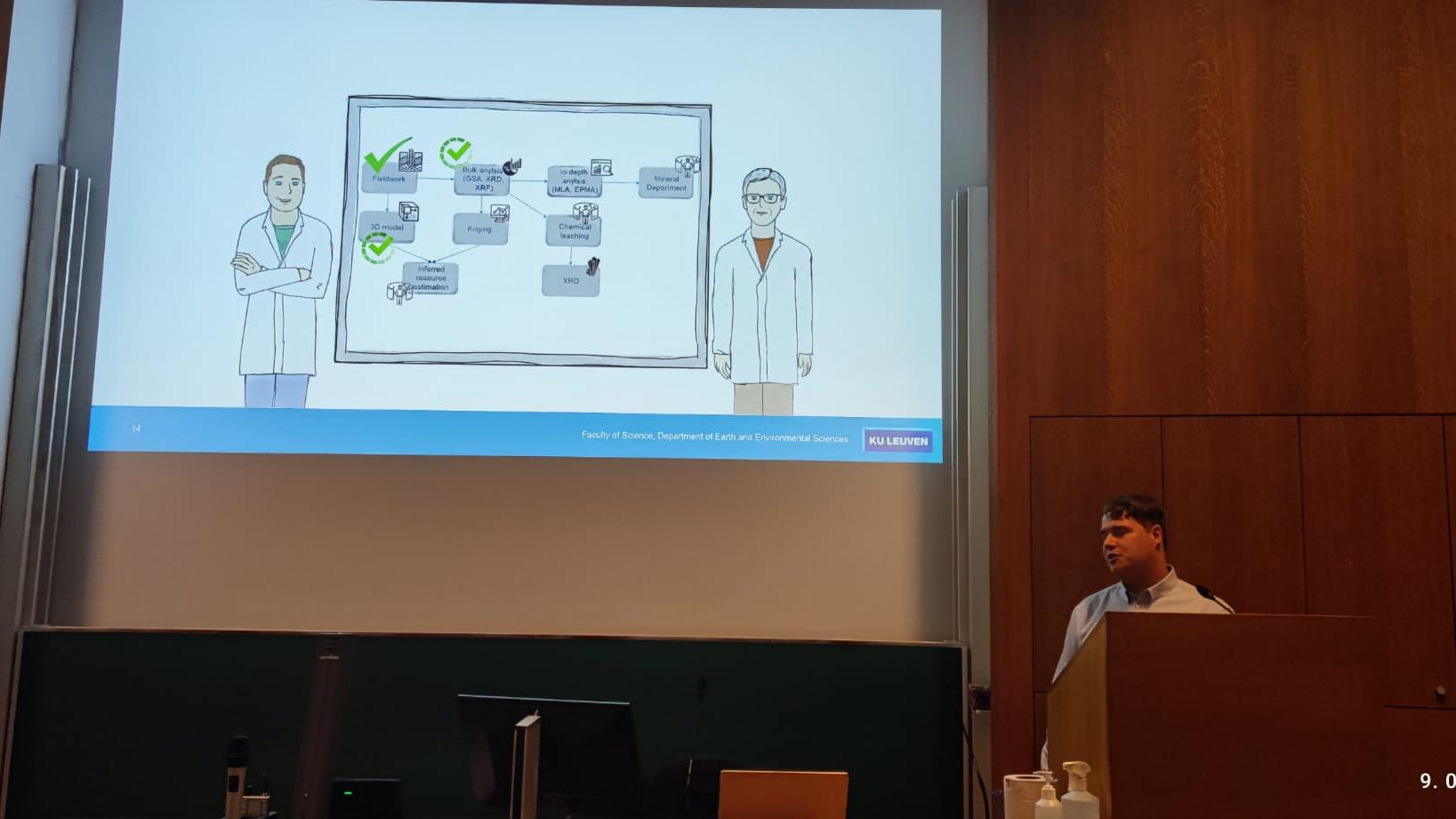On May 9, 2022, Srećko Bevandić (SIM2 KU Leuven Institute and Early Stage Researcher in the MSCA-ETN SULTAN project) obtained his PhD degree in Geology. He successfully defended his PhD thesis entitled “Geometallurgical characterisation of Zn-Pb mine waste in view of (near) zero-waste valorisation; Plombières, East Belgium”.
Srećko Bevandić carried out his PhD in the Ore geology and geofluids group of Prof. Dr. Philippe Muchez, his supervisor. The PhD research was part of the H2020-MSCA-ETN SULTAN project, the EU Training Network targeting the remediation and reprocessing of sulphidic mining wastes. Dr. Srećko Bevandić will continue his career in the Avesta Battery & Energy Engineering group, as project engineer.

The popularised summary of the PhD research along with list of publications are available below; the full text of the thesis will be made publicly available in due time.
Abstract:
Mine waste deposits around the globe still contain many residual metals and/or metalloids that were previously not extracted. With improved processing and extraction techniques, mine wastes may thus be of significant economic interest as secondary raw materials, but they can also pose an environmental threat. Due to advances in the characterisation, processing and recovery of ores from host rock, modern mine waste has a significantly lower content of residue metals/metalloids making them less viable than historic mine wastes. In addition to this, the development of modern technologies resulted in a consortium of metals that were not previously of economic interest. Consequently, the reuse of mine waste could contribute to more sustainable mining and mitigate the environmental threat that these materials are posing.
Low-grade deposits are requiring a way of characterisation that will lead to tailoring most optimal processing methods for target metals in order to make these deposits economically feasible. A most suitable way of doing this is by integrating a geometallurgical characterisation in the whole process. This kind of characterisation tends to link mineralogical and geochemical variability with metallurgical proxies. Up to date, geometallurgical characterisation is integrated into maximising potential of the primary deposits, but has rarely been used for characterisation of low-grade deposits such as mine waste.
This research aims to develop and apply a suitable method that can be used for geometallurgical characterisation of different types of mine waste deposits around the globe. The Plombières tailings pond (East Belgium) was selected as a case study for developing a methodology. The methodology developed should be suitable for the characterisation of mine waste deposits that originated from different ore types and different processing methods that were used to produce the Plombières mine waste.
The Plombières tailings pond is the result of the pyrometallurgical processing of a Mississippi Valley-type (MVT) ore. The exploitation of the ores at Plombières started already during Roman time and lasted until 1922. The Plombières MVT ore was used for extraction of lead, zinc and for a short period of time for extraction of silver. The MVT ores could also be a source of critical metals such as indium, gallium and germanium, which were not mined in the past from the Plombières ore. Therefore, there is a potential that these metals, together with residual lead and zinc are present within the Plombières tailings pond.
In this thesis, a methodology for geometallurgical characterisation is developed by combining and modifying a series of different methodologies commonly used for the characterisation of primary ore deposits. Mineralogical and geochemical characterisation methods are integrated with hydrometallurgical, geospatial and mineral resources assessment methods in order to establish the potential of the waste deposit.
The occurrence of the Plombières tailings pond has been described and four main types of mine waste were identified in the field: a soil, metallurgical waste, brown and yellow tailings. The depth of the tailings pond was estimated by using the results of the sampling campaign and of a geophysical survey that combined Electrical Resistivity Tomography (ERT) with Induced Polarisation (IP). The depth of the tailings pond was estimated to be 8 m, with the yellow tailing as the most prominent layer. Geochemical analysis using X-ray fluorescence (XRF) showed that all four types of mine waste consist dominantly of SiO2, Al2O3 and Fe2O3. Geochemical data revealed that only base (lead and zinc) metals are of economic interest, while critical elements such as indium, gallium and germanium are present in negligible concentrations. Base metals of interest (lead and zinc) show a strong variability. The content of lead and zinc are ranging from 10 ppm to 10.1 wt. % and from 53 ppm to 24.0 wt. % respectively. The highest concentrations of metals of interest are present within the metallurgical waste layer, while the yellow tailing has the lowest concentrations of metals of interest. Mineralogical analysis preformed with X-ray diffraction (XRD) indicated that the same three main phases are present in different types of mine waste, i.e. quartz, slags and phyllosilicates, together with a minor amount of Fe-, Pb- and Zn- bearing minerals. Based on the XRD results, lead and zinc values were calculated. Calculations showed an under-estimation of the lead and zinc content based on the minerals identified in the samples studied. This has been explained by the presence of important quantities of lead and zinc within the amorphous structure of the slags.
A combination of Scanning Electron Microscope (SEM)-based Mineral Liberation Analyzer (MLA) and Electron Probe Micro-Analyzer (EPMA) allowed the identification and quantification of lead- and zinc- bearing phases, including minerals present in low abundances as well as slag phases. The integrated approach revealed both lead- and zinc-bearing minerals that were not detected with XRD. Lead minerals identified are Pb-oxides (PbO/PbO2), anglesite (PbSO4), cerussite (PbCO3), plumbogummite (PbAl3(PO4)2(OH)5·5H2O and Ca-pyromorphite ((Pb,Ca)5(PO4)3Cl). The following Zn-bearing minerals were detected within different types of mine waste: sphalerite (ZnS), smithsonite (ZnCO3), gahnite (ZnAl2O4), willemite (Zn2SiO4), bannisterite ((Ca, K)(Mn2+, Zn, Fe2+)10(Si, Al)16O38(OH)8 · nH2O) and fraipontite ((Zn, Al)3(Si, Al)2O5(OH)4). In addition, four types of slags are described: SiO2-rich (SiS), SiO2-Al2O3-rich (SAS), Fe2O3-rich (FS) and PbO-ZnO-rich (PZS) slags. Lead-zinc-, iron-rich slags and Pb-oxide are the main source of lead in the different types of mine waste, followed by cerussite and/or anglesite. Fraipontite and/or slags are main zinc host, with minor amounts contributed by sphalerite, gahnite, willemite and bannisterite.
Based on the deportment model, hydrometallurgy was selected as the most suitable method for processing of different types of mine waste. Sulfuric acid, methanesulfonic acid, and sodium hydroxide solutions were selected as lixiviants for hydrometallurgical extraction of metals of interest. Sodium hydroxide gave the best results, due to a low or negligible concentration of Fe in the pregnant leaching solution. In addition to that, leached metals did not precipitate into new mineral phases. Regardless of the lixiviant and the material used, the leaching efficiencies are low. However, the highest leaching efficiency of both lead and zinc is achieved for samples where lead- and zinc-bearing minerals were significantly present, while negligible concentrations of lead and zinc were measured in samples dominated by slags. This indicated that slag phases are inert and without optimization will not leach significant concentrations of lead and zinc.
The four different layers described at the Plombières tailings pond were modelled by using Universal Kriging (UK) to establish the metal distribution of lead and zinc. The results showed that high concentrations of metals occur in the north-eastern part of the tailings pond. The spatial properties were combined with geochemical data to calculate the average grade of each layer and of the whole secondary deposits. Based on the quantity and quality of the information (level of geological knowledge, sampling, chemical assay, metal grade and tonnage, level of certainty) the different layers of the Plombières tailings pond meet the requirement for their classification as indicated or inferred resources, depending on the layer. If uncertainty is more than 35 % at the 95 % confidence interval (CI) the layer is classified as an inferred mineral resource, while layers where uncertainty is between 20 and 35 % at the 95 % CI are classified as indicated resources. However, since the tailings pond is considered as one whole unit it only meets requirement for classification as an inferred resource.
This thesis presents a methodology used for geometallurgical characterisation of different types of mine waste that consist of both mineral and non-mineral phases, but also shows how to adequately characterise mine waste material that has a high heterogeneity. The methodology described can be used for the geometallurgical characterisation of different types of mining waste deposits around the globe.
List of peer-reviewed publications in scientific journals:
First author:
Bevandić, S., Blannin, R., Auwera, J. Vander, Delmelle, N., Caterina, D., Nguyen, F., & Muchez, P. (2021). Geochemical and mineralogical characterisation of historic Zn–Pb mine waste, plombières, East Belgium. Minerals, 11(1), 1–27. https://doi.org/10.3390/min11010028.
Bevandić, S., Xanthopoulos, P., & Muchez, P. (2021). Chemical Leaching of Sulfidic Mining Waste, Plombières Tailings Pond, Eastern Belgium: Insights from a Mineralogical Approach. Journal of Sustainable Metallurgy, 7(4), 1444–1455. https://doi.org/10.1007/s40831-021-00445-0.
Bevandić, S., Blannin, R., Gomez-Escobar, A; Bachmann, K; Frenzel, M; Pinto, A; Relvas M. R. S. J (2021). Metal deportment in Pb-Zn mine wastes from a historic tailings pond, Plombières, East Belgium. Minerals Engineering, 184, 0892-6875. https://doi.org/10.1016/j.mineng.2022.107628
Co-author:
Xanthopoulos, P., Bevandić, S., Spooren, J., Binnemans, K., Kukurugya, F. (2022). Recovery of copper, zinc and lead from photovoltaic panel residue. RSC ADVANCES, 12 (4), 2351-2360. https://doi.org/10.1039/D1RA09268E.
Cappuyns, V., Campen, V.A., Bevandić, S., Helser, J., Muchez, P. (2021). Characterization of Mine Waste from a Former Pb–Zn Mining Site: Reactivity of Minerals During Sequential Extractions. Journal of Sustainable Metallurgy, 1-13. https://doi.org/10.1007/s40831-021-00455-y.





